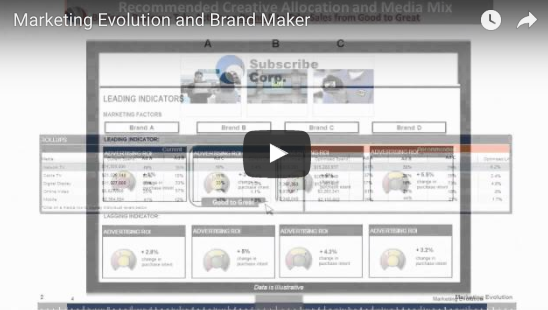Everything You Need to Know When Using an Omnichannel Attribution Strategy
 Consumers today have a lot of options when it comes to choosing the brands they engage with. Given the overwhelming amount of advertising they experience in their day-to-day lives, it’s the marketing efforts that address consumers’ specific needs and interests that win their attention.
Consumers today have a lot of options when it comes to choosing the brands they engage with. Given the overwhelming amount of advertising they experience in their day-to-day lives, it’s the marketing efforts that address consumers’ specific needs and interests that win their attention.
With this in mind, marketers need the ability to attribute the impact of each consumer touchpoint and their influence on additional touchpoints across the marketing mix. This will allow marketers to provide consumers with the relevant, targeted experiences that get their attention.
In order to measure this impact across online and offline channels, marketers need an omnichannel strategy that leverages marketing attribution to generate a holistic, 360º view of their marketing mix effectiveness, combining a variety of unique measurements and external data. Omnichannel attribution provides the comprehensive insights marketers need, while highlighting the key ingredients and platform capabilities required for cross-channel campaign success.
Incorporating Attribution into an Omnichannel Strategy
The modern consumer demand for personalized and relevant marketing provides a unique opportunity to deliver more targeted ads and creative messaging to consumers. Given that consumers engage with media across online and offline channels, marketers have subsequently adopted an omnichannel strategy to better meet their demands and engage them across media.
To effectively optimize marketing efforts with an omnichannel strategy in mind, marketers need to collect consumer data from across the marketing mix—online and offline. From there, they can generate data-driven insights into where, when, and how consumers are engaging with campaigns. Additionally, marketers need the ability to measure the impact of various channels across the entire marketing mix.
Put another way, omnichannel marketing requires attribution strategies that have the capability to measure and score cross-channel efforts. This omnichannel attribution strategy helps marketers understand each complex relationship between channels, touchpoints, messaging, and external factors—across traditional and digital mixes. This allows marketers to recognize the significant opportunities to optimize each element of their campaign, while remaining aligned with their omnichannel marketing strategy.
Key Ingredients for an Omnichannel Attribution Strategy
In order to accurately measure the success of their omnichannel strategies, it’s crucial that marketers choose an attribution model that provides them with access to the right data. Specifically, marketers need:
Sales data at the person-level
Marketers need to understand their holistic marketing spend while having the ability to tie individual sales to specific consumers. To do this, marketers can leverage the sales data from company CRM platforms, third-parties like internet service providers (ISPs) and digital service providers (DSPs), or substitutes like in-store visits. This information gives marketers an accurate baseline of total marketing spend that can be narrowed down to the person level when attributing specific consumer engagements down the sales funnel.
Aggregate and person-level measurements
Marketers need data that highlights key consumer trends across both the marketing landscape and the individual channels used in campaigns. By combining the high-level insights generated through aggregate measurements like marketing mix models, with channel-specific insights into where, when, and how to engage consumers shown in multi-touch attribution, marketers gain a holistic view into their marketing efforts. These insights can then be used to strategically enhance campaigns.
External data
For accurate omnichannel measurement, marketers need data that provides insight into demographic behaviors, weather, proximity to brick and mortar locations, the impact of brand authority on conversion propensity, etc. With external data, marketers can gain an increasingly granular view at what drives consumers to engage with channels and allows for more effective attributions.
Insights into offline/online trends
To understand when, where, and how consumers want to be reached, marketers need to identify the specific customer journeys their target audiences follow across online and offline channels. With this information, marketers can then understand how their efforts influence consumer behavior across their entire marketing mix.
Insights into channels that work
Given the wide range of channels available to marketers today, it makes sense to assume that some will have significant impact on marketing efforts, while others will fall short. In order to get the most out of an omnichannel attribution strategy, it’s crucial that marketers focus their efforts across channels that work.
Choosing the Right Vendor for Omnichannel Attribution
Accurate attribution is a key component to a successful omnichannel strategy. To understand and attribute omnichannel marketing efforts, marketers need a data analytics platform with the capability to merge disparate measurements together into a 360º view of marketing performance. Additionally, attribution efforts need to be done in-campaign down to individual consumers. Marketers should also look for providers that have access to outside data needed to track sales down to the person-level, across online and offline engagements.
Finally, it’s important to consider whether or not the vendor can provide granular insights that can be used in-campaign for rapid optimizations that keep up with today’s changing consumer trends.
Final Thoughts
To measure the wider marketing mix used to reach and engage with consumers today, marketers need to incorporate various attribution metrics into their omnichannel strategy. Merging these disparate marketing measurements together allows for a holistic view into marketing effectiveness. With the right data in place to properly measure offline and online marketing efforts, along with the appropriate analytics platform capable of correlating that data, marketers can find opportunities for media mix optimization leading to improved results.






















